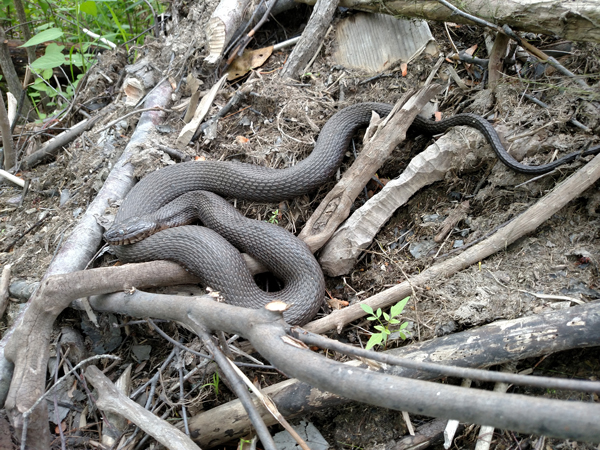Maintaining northern water snakes in captivity can be a rewarding experience.
As a New Englander there are not a lot of herp-related thrills to look forward to for much of the year. I can remember a childhood of long drawn out winters while growing up on Cape Cod in Massachusetts, desperately awaiting the onset of spring and the emergence of any herp-related creature I could get my hands on. There wasn’t much to choose from in this part of the continent but of the herps that we did have, many were early risers.
Northern Water Snake
- Family: Colubridae
- Adult Size: 3 to 4 ft.
- Range: southern Ontario and Quebec Canada south throughout the eastern United States from Maine to coastal North Carolina and portions of South Carolina and Georgia, west to eastern Louisiana, north to east Colorado and north east through Minnesota
- Habitat: Beaver dams, lakes, ponds, marshes, rivers, canals, and other bodies of freshwater
- Care Level: Intermediate
Amongst the earliest were the spotted salamanders, spotted turtles, painted turtles, garter snakes and the hulking northern water snakes all of which could be found by mid to late March and early April. I certainly kept my share of water snakes throughout my youth and right on up through adult hood, never tiring of their impressive size and passive captive demeanor. Water snakes in general seem to be relatively intelligent snakes, in tune to what’s going on with their surroundings and often curious about the activities of humans, sometimes associating people with food. It is not unusual for water snakes of many species to take note of the human fisherman and to actually follow a fresh catch right into shore, sometimes latching on to it! Keeping the water snake and other “gateway” herps as a child produced the strings that tied me into a lifetime of herp study and a solid, permanent bond with nature.
Northern Water Snake Taxonomy, Range & Description

leo spinner
An adult northern water snake rests atop an old beaver dam soon after spring emergence.
First described by Linnaeus in 1758, the northern water snake, like most snakes have gone through much taxonomical change. The most familiar being the attested Natrix sipedon ssp., by Stejneger and Barbour 1917, and back again to Nerodia sipedon ssp., Stebbins 1985.
The species is composed of four sub-species:
- Nerodia sipedon sipedon – The northern water snake
- Nerodia sipedon williamengelsi – The Carolina water snake
- Nerodia sipedon pleuralis – The midland water snake
- Nerodia sipedon insularum, the Lake Erie Water snake.
Found from southern Ontario and Quebec, Canada south throughout the eastern United States from Maine to coastal North Carolina and portions of South Carolina and Georgia, west to eastern Louisiana, north to east Colorado and north east through Minnesota, the northern water snake is a widespread familiar species that draws a lot of conflicting feelings among those who experience it.
A heavy bodied snake often reaching lengths of three feet with females sometimes as large as 53 inches in length, northern water snakes are one of the most frequently encountered snakes in the east and are often confused with the venomous cottonmouths in spite of the fact that they are not often encountered together and share a very dissimilar appearance.
Northern water snakes are a heavily armored snake with thickly keeled scales and range in a wide variety of colors, often making its identification difficult in areas of its range where it overlaps with other species in its genus. Shades of brilliant crimson and black as well as orange, silver and brown are not uncommon. Dark black, almost melanistic specimens are commonly found. The ventral scales of the northern water snakes may be anywhere from silver and grey to a uniform brown with little patterning or brilliant reticulations of crimson, black and white.
Northern Water Snake Behavior

leo spinner
Leo Spinner Jr., holds a freshly caught northern water snake on Cape Cod in Massachusetts.
Predators and Self Defense: Northern water snakes have a variety of defense mechanisms that help them survive under harsh conditions. When first encountered, northern water snakes often spread their head, neck and body to a remarkable degree often striking repeatedly at would be attackers. An anticoagulant saliva causes much bleeding from a victim but is rarely harmful. Northern water snakes are often known to smear a combination of feces and musk when molested by a person attempting to catch her however after such duress she will eventually become lucid and accept defeat. Northern water snakes will typically remain quite calm for the rest of their captive lives.
Brumation: Northern water snakes often travel great distances from water and often show up under very extraordinary conditions. The author has found northern water snakes hiding beneath railroad ties, well away from standing water and in areas where only vernal pools exist. I have also found northern water snakes on dry mountainsides up to two miles from standing water. In winter, water snakes will often brumate far from water and it is not unheard of for them to brumate with species such as the black rat snake, copperhead and timber rattlesnake in habitats where they are found.
Reproduction: Reproduction typically occurs at the onset of spring from April and into July with offspring being born in late summer typically from August through October. Although 12 to 24 offspring is more common, a litter of 44 offspring has been documented, Ditmars 1936. Juveniles of the northern variety are quite striking with an immaculate white or grayish base color adorned with jet black cross bands.
Captive Care: Northern water snakes can be maintained rather easily in captivity as long as a few notable points are adhered to. Although fresh drinking water should be available at all times, care should be given to keep the rest of your northern water snakes captive environment dry. Water snakes are extremely susceptible to scale rot, an infection related to bacteria caused by an inability to dry out completely. Although topical solutions are available to treat this and in some cases antibiotics, it is simply best to prevent scale rot from manifesting itself in the first place.
Many types of substrate for this species, including rubber backed commercial carpet and the various types of dry mulch can be used in your snakes’ enclosure. The author prefers rubber backed carpet as far as convenience of cleaning goes but has also been known to use ground pine bark mulch. Pine bark mulch is acidic and retards the growth of harmful bacteria and fungus.
It is important to provide an overhead light for your water snake and a full spectrum heat bulb would be ideal. Water snakes spend a great deal of the day basking at different levels beneath the heat bulb and likely benefit from the full spectrum rays. A strong branch to support an adult-sized snake is essential.
Most available water snakes are not captive born and are typically carriers a heavy parasite load. Newly acquired water snakes should be treated for worms and microbes and products related to parasite treatments such as Panacur and Flagyl can often be purchased through your local veterinarian.
Water snakes can be maintained on a diet of fish, frogs and salamanders and some individuals have been known to take small rodents as well. Be vigilant in keeping your northern water snakes environment clean and you will avoid a lot of grief. Northern water snakes become quite tame in captivity and their feeding reflex is triggered primarily by smell not motion so they are not likely to grab you while reaching into an enclosure the way some tame king snakes and rat snakes may do.
Captive Breeding: As is typical with most North American colubrids, captive breeding is achieved through proper conditioning of the adult snake. A cooling down period is necessary in this species to trigger reproductive materials into activation which will ultimately lead to viable offspring. After a gradual cool down to 50 degrees Farenheit, snakes will be in dormancy for up to three months at which time temperatures will be gradually brought back up to the norm for this species.
Upon spring emergence, your water snakes will resume feeding and reproductive activities will begin soon after, typically within two to four weeks. Females produce a pheromone or sex hormone which will attract the males of her own species. Males will actively pursue females while making frequent attempts at copulation. A receptive female will raise her tail and the two snakes will remained locked up for as long as 20 minutes while reproduction occurs. Several months later a gravid female will deliver her babies sometimes still present in their amniotic sacs; this form of delivery is called ovoviviparous because the neonatal transparent egg sac is born along with the snake. Most individuals will have no trouble freeing themselves from their natal sacs but weaker individuals may perish without ever taking that first breath of fresh air.
Neonate Care: Northern water snakes typically have between 12 and 24 offspring but numbers as high as 44 have been recorded and still, claims of even greater numbers have been made. Juvenile water snakes require the same care as the adults, only on a smaller degree. Fresh water and a dry captive environment is a must while food items such as fish, frogs and salamanders offered after the first shed will be taken with motivation. It is extremely important to separate the offspring during feeding and preferably at all times. Juvenile water snakes have a tremendous appetite and will not hesitate to consume litter mates, which often leads to the death of both snakes involved.
Closing: Maintaining northern water snakes in captivity can be a rewarding experience and a large specimen on display can be quite impressive even to the well-seasoned herpetologist. It is common enough so most people will recognize it in your collection but so common that few people actually keep it, making it even that much more of a conversation piece. Afford your water snake a clean, spacious enclosure and a well-rounded diet and your specimen will rival even the most exotic of snakes you may keep.
Leo Spinner owns and operates “The Spotted Turtle Herpetological Institute” and “Skin and Scales Live Animal Presentations.” He has over forty five years of experience keeping, breeding and researching Reptiles, Amphibians and Invertebrates. He is a Cape Cod native and resides in Massachusetts with his family.



